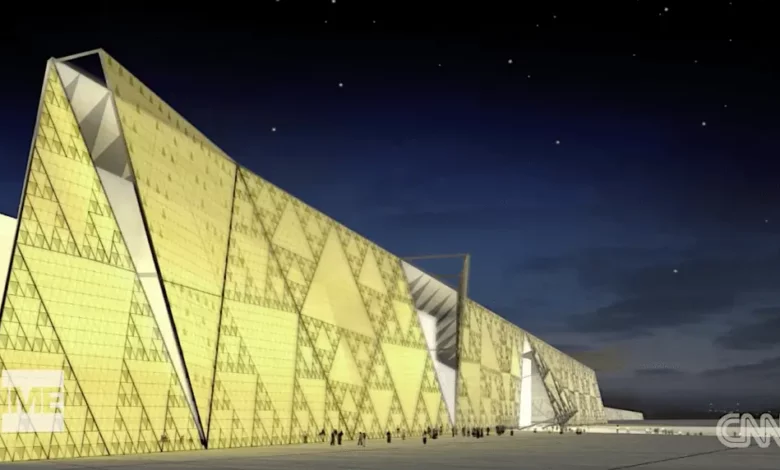Egypt’s $1Billion Museum to Open in November 2022

The Grand Egyptian Museum will cost more than $1 billion, and will house and repair some of the country’s most valuable artifacts, expected to receive around 5 million visitors yearly.
Its vast, glass-fronted structure provides panoramic views of the Giza plateau and the Great Pyramids, which are only two kilometers distant. 5,000 construction workers worked around the clock to finish the long-awaited Grand Egyptian Museum on the outskirts of Giza’s ancient pyramids.
The 5.2-million-square-foot structure will be the world’s largest museum dedicated to a single culture, according to the aspiration of Khalid al-Anany, Minister of Antiquities. The antiquities on show would be linked to the Pharaonic, Greek, and Roman civilization, with opening estimated for November 2022.
Khaled al-Anany revealed in 2017 that Japanese loans (provided by Japan International Co-operation Agency (JICA)), to the Egyptian government covered 75% of the cost. It will house 100,000 items, according to the state-run newspaper Al-Ahram, 4,549 of which will be from the tomb of the famous King Tutankhamun.
The colossal 3,200-year-old statue of Ramses II that had previously stood in the centre of Cairo’s Ramses Square was one of the first objects to be relocated to the Grand Egyptian Museum.
Despite the fact that the new museum was still under construction at the time, the authorities chose to move the 83-ton statue to the conservation center in 2006 to prevent it from deteriorating due to the pollution that had surrounding it throughout its five-decade stay in the square. In 2018, the statue was relocated to the museum’s main entrance for its last resting place.
“This will be the museum of the 21st century,” said its director general, Tarek Tawfik.
“All means of modern technology have been taken into consideration in order to make this an unforgettable experience for the visitor, but at the same time provide the best possible environment for the artifacts.”
Read Also: Oxford University Publish 145 Stolen Benin Artefacts in Pitt Rivers Museum
The schematics
The proposal for the Grand Egyptian Museum was first revealed in 1992, when a Presidential Decree was issued. Almost 50 hectares were set aside for a state-of-the-art new facility. Following the announcement, in 2002, a competition was held to find out who would design the new museum.
According to the Egyptian government, the main contract for the design of the Grand Egyptian Museum was awarded to the Irish architectural firm Heneghan Peng in 2003 after the extensive international competition, but the design phase of the project involved a team of 300 people from 13 companies in six different countries.
Pre-schematic design, schematic design, detailed design, tender documents, and construction drawings were all part of Heneghan Peng’s scope of work. The firm also collaborated closely with mechanical and structural experts BuroHappold Engineering and Arup, finishing their first design by the end of 2005 and initiating the design for the museum building the following year.
The triangular form of the 500,000-square-meter structure resembles the nearby pyramids. The north and south walls are aligned with Khufu’s and Menkaure’s pyramids. It will include a vast atrium on the inside where gigantic statues can be displayed. The museum will be three stories tall, featuring meeting rooms and teaching areas on each level. A 250-seat 3D theater, a children’s museum, shops, and eateries will all be located there.
Hill International agreed to offer project management services to Egypt’s Ministry of Culture and EHAF Consulting Engineers throughout the museum’s design and construction in 2010. In 2012, construction on the new location began.The Grand Egyptian Museum’s Tutankhamun galleries, as well as the Grand Stairs, the Piazza Atrium, and the Children’s Museum, were designed by German architecture firm Atelier Brueckner in 2016.
Read Also: France Returns Artefacts Stolen from Benin Republic
Architectural delays
There have been many delays to the project over the years. This means that the initial goal to open in 2011 was pushed back multiple times. The Arab Spring, which erupted in 2011 and resulted in political instability, protests, and a temporary curfew, was also a big issue.
In 2018, the museum announced that it would eventually open in 2020. The COVID-19 epidemic, on the other hand, forced a further postponement.
The museum announced in February 2021 that 98 percent of the engineering facility construction work had been completed. Simultaneously, it said that it intends to open in the fourth quarter of this year. This has now been postponed until 2022.
Source: Blooloop | CNN
Abeeb Lekan Sodiq is a Managing Editor & Writer at theafricandream.net. He’s as well a Graphics Designer and also known as Arakunrin Lekan.





